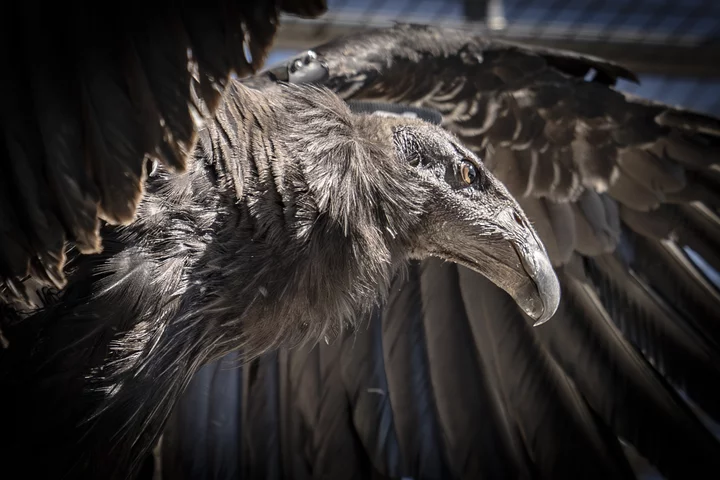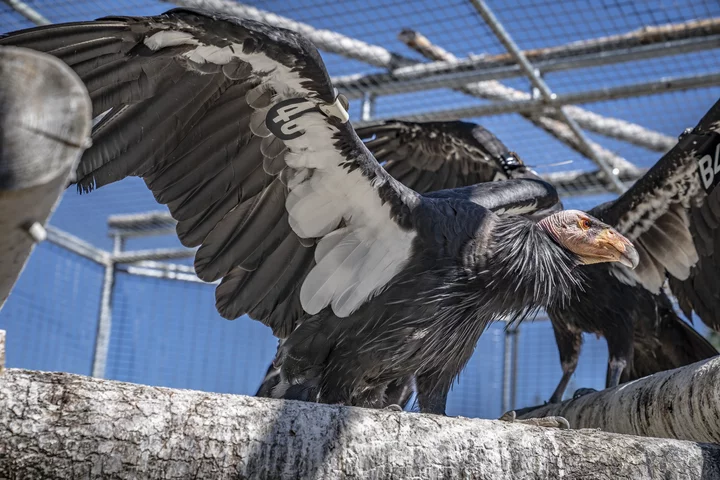One of the new birds. Photo: Maddy Rifka for the Yurok Tribe.
For the first time in more than a century, California condors soared last month over the ceremony grounds of Woo-neek’ ‘we-ley-goo, a ten-day Yurok ceremony also known as the Jump Dance. Akin to a new year, the name more directly translates to “raising up ceremony,” said Yurok descendant and Hoopa member Ryan Matilton, who works as a biologist for the Yurok Tribe. California condors, or prey-go-neesh, are important to the event.
“During the ceremony we have baskets and we raise them up to the sky, essentially lifting our prayers up to the heavens,” Matilton said. “And that’s where the condor comes in, because in Yurok belief they are the highest flying in the sky, and they are thought to carry our prayers to the heavens. So, you know, we can only lift them so far. They take it the rest of the way.”
“Having them back is a huge deal.”
They’re back because of the Northern California Condor Restoration Program, which began reintroducing prey-go-neesh to Yurok ancestral territory in 2022. Thousands of years ago, the scavengers thrived in California and beyond, but their numbers drastically dropped with settler colonialism. By 1982, there were only 22 California condors left in the wild, according to the U.S. Fish and Wildlife Service.
The Northern California Condor Restoration Program is a collaboration between the Yurok Tribe, Redwood National and State Parks and U.S. Fish and Wildlife Service, and oversees a restoration site in Redwood National Park. Of the six facilities reintroducing California condors in the state, it is the northernmost site by about 450 miles.
Thanks to the program, our region’s prey-go-neesh population of 11 birds will soon increase by more than 50 percent.
Five new younglings – aged 14 to 16 months – arrived last month from a Los Angeles zoo and have been acclimating in a closed pen with an older mentor condor. Two of them will be released on Tuesday, and the others will join in the following weeks. You can view the group hangin’ out on this live feed.
Two more zoo transplants will arrive later this month and are expected to take to the skies around the end of September.
Though the first of the flock were released just two years ago, the Yurok Tribe has been working to reintroduce condors to the region since the early 2000s, said Chris West, a senior wildlife biologist for the tribe who manages the program. After years of securing grant funding, navigating bureaucratic hurdles and scouring the habitat for contaminants, it was finally time to construct and populate a reintroduction site.
Reintroducing California condors isn’t as simple as unleashing a newborn onto the landscape, though.
“Condors are a really unique species,” West said. While many birds can survive on their own instincts after fledging the nest, condors rely on their parents to learn and survive for the first year and a half of their lives. After that, juvenile birds flock and learn from one another for years, and don’t start breeding until age seven or so.
“Because of that, it makes releasing them a little trickier,” West said. “You’re now trying to release a young bird that doesn’t have mom and dad, and so you have to take the place of [them], and at the same time do it from behind the scenes where they can’t see you and imprint on you.”
Restoration programs have spent decades figuring out how to best replicate that environment, West said. A proper release site is a social hub for young and naive birds.
“It brings the birds together,” West said. “You can provide resources for them, you can provide safety for them, and you can do it all from hiding in the bushes, hiding behind the scenes so the birds don’t see you, don’t know that it’s happening.”
Even following release, the condors continue to rely on the site as a home base. Staff provide food year-round and lure each bird into traps twice a year for physical exams and to test for avian influenza and lead exposure.
Fragmented lead bullets are the biggest threat to Condors these days, even though the ammunition has been illegal in California since 2019. In the two years since reintroducing condors to the northwest, at least five poaching events have put the birds at risk, West said, noting that there could have been more. In 2023 one condor had to be treated for lead poisoning at the Sequoia Park Zoo after scavenging a poached elk carcass.
The most recent (and extreme) case was the killing of four elk near Bald Hills Road just last month. Matilton, who was participating in Woo-neek’ ‘we-ley-goo not far from the poaching, was one of the first to arrive at the scene after the elk were discovered. Condors found the dead elk first.
“It was pretty horrible,” Matilton said. “I’ve lived here my whole life and honestly never seen anything of the like.” It was an unusual case because the four elk were shot but left otherwise untouched. Everything about it upset Matilton: the threat to the condors; the disrespect and waste of the elk; and the blame tribe members face after poaching events, he said.
Soft, dense and malleable, many types of lead bullets mushroom and fragment when they hit an animal, shedding energy and shattering into tiny pieces.
“All of those little pieces are toxic,” West said. “If you can see the piece and pick it up – of which there are hundreds – then that’s going to be enough lead to kill a condor or an eagle or a vulture.”
In this case, West said that none of the local condors appear to have ingested lead fragments before people intervened.
Not everyone knows about the lead bullet ban, and the tribe wants to get the word out about why the ammunition is dangerous to wildlife. “Regulation seems easy, but it’s not easy, and I don’t think you win the hearts and minds of the people that you really need to be engaging with,” West said.
But reaching one sector of the audience – poachers – is a challenge.
“How do you engage with a poacher who’s already doing an illegal activity and get them to make a transition to a less impactful form of take?” West said. “That’s something we haven’t totally figured out.”
Permitting for the Yurok Condor Restoration Program is set for two decades, but the program may be extended. Obviously, the hope is that the California condor population will eventually be self-sustaining.
“A lot of it is going to be dependent on lead,” West said. “A lot of the other sites are saying: ‘Wow, we could just stop doing this tomorrow, if we didn’t have birds dying from lead all the time.’ […] If it ended today, I would feel pretty confident that 20 years is all we would need. But it’s not going to end today.”
Folks who see anything suspicious are encouraged to call the California Department of Fish and Wildlife at (888) 334-2258.
“The condor restoration program, to the Yurok people, it’s more than just the reintroduction of a bird, of an animal to the landscape. It’s like the reintroduction of a piece of our culture,” Matilton said.
“A lot of the elders now – their grandparents, and some of them themselves […] – they went to boarding schools. They were sent away. And the fact that they were able to come back and help my generation bring the culture back … I feel like they feel akin to the condor in that respect – that the condor was extirpated from this area, but it came back. We brought them back.”
The mentor condor, Paaytoquin. Photo: Maddy Rifka for the Yurok Tribe.


CLICK TO MANAGE